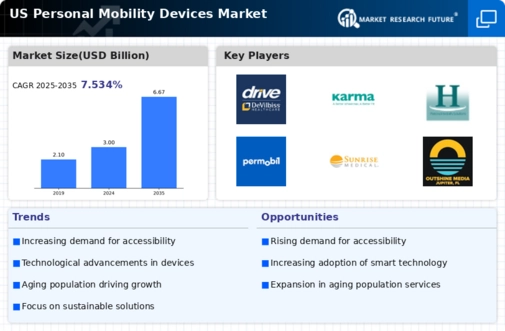The US Personal Mobility Devices Market is characterized by a competitive landscape that is continuously evolving, driven by the increasing demand for innovative mobility solutions among an aging population and individuals with disabilities. This market encompasses a wide array of products designed to enhance mobility, including wheelchairs, scooters, walkers, and other assistive devices. As the market witnesses the ongoing integration of advanced technology, stakeholders are focusing on product differentiation to establish a strong foothold. Competitors are distinguishing themselves through enhanced features, improved ergonomics, and user-friendly designs, all aimed at accommodating the specific needs of consumers.
Companies that adeptly navigate market trends, regulatory challenges, and consumer preferences are likely to secure a competitive edge in this dynamic arena. Drive DeVilbiss Healthcare stands as a prominent player in the US Personal Mobility Devices Market, renowned for its extensive range of mobility solutions that cater to diverse consumer needs. The company is acknowledged for its commitment to quality and innovation, routinely enhancing its product offerings to meet the evolving demands of users. Its strength lies in its robust distribution network and strong brand reputation, which have earned it a loyal customer base.
Drive DeVilbiss Healthcare leverages cutting-edge technology in its mobility devices to ensure safety, reliability, and comfort, thereby enhancing the overall user experience. The firm's focus on customer-centric design and durable, high-performance products substantially contributes to its competitive position within the US market. Karma Mobility has established a significant presence in the US Personal Mobility Devices Market by offering a diverse portfolio of high-quality products, including folding wheelchairs and electric scooters tailored for individuals with varying mobility needs. The company's strategic emphasis on lightweight yet durable designs positions it as a favorable option among users seeking convenience without compromising quality.
Karma Mobility is recognized for its agility in innovation, frequently updating its offerings to encompass the latest advancements in mobility technology. The company’s strengths include an extensive network of partnerships and collaboration within the healthcare sector, enabling it to maintain a competitive edge. Additionally, Karma Mobility has strategically engaged in mergers and acquisitions to enhance its product line and market share in the US, further solidifying its reputation as a key player dedicated to improving the quality of life for individuals with mobility challenges.












